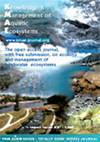欧洲某水坝水库外来滨-里海片足类近岸分布与基质类型和大型无脊椎动物类群的关系
IF 1.7
3区 环境科学与生态学
Q3 FISHERIES
引用次数: 5
摘要
了解入侵物种的栖息地要求和种间相互作用有助于预测其影响和传播。我们确定了入侵淡水庞托-里海片足类组合内部的关系,以及它们与中欧低地水坝水库近岸带大型无脊椎动物的关系。我们在4个日期(2015年10月- 2016年10月)取样了5种生境类型:水线处的裸沙、裸沙(深度为0.2 m)、裸沙(深度为0.5 m)、大型植物覆盖的沙(深度为1 m)、石头(深度为0.3 m)。所有生境中均有粗犷长尾马,长尾马和长尾马仅分布于石质底。除Dikerogammarus幼鱼外,片足类种群密度呈显著正相关,与成虫呈显著负相关。绒毛D.、Dikerogammarus幼鱼和ischnus幼鱼的出现与形成遮蔽的双壳类Dreissena polymorpha的存在呈正相关。Pontogammarus robustoides与球形蛤和腹足类(避难所)以及寡毛纲和手拟纲(潜在猎物)呈正相关。长尾角麻鼠和ischnus分别与手纲动物和寡毛纲动物呈正相关。各种外来片脚类动物在研究区域的共存,表明它们在组合中普遍存在正相关关系,这可能是由于庇护所的丰富和食物来源的丰富允许栖息地划分。本文章由计算机程序翻译,如有差异,请以英文原文为准。
Near-shore distribution of alien Ponto-Caspian amphipods in a European dam reservoir in relation to substratum type and occurrence of macroinvertebrate taxa
Knowledge of habitat requirements and interspecific interactions of invasive species helps predict their impact and spread. We determined the relationships within the invasive freshwater Ponto-Caspian amphipod assemblage, and their associations with macroinvertebrates in the near-shore zone of a central European lowland dam reservoir. We sampled five habitat types: bare sand at the water line, bare sand (0.2 m depth), bare sand (0.5 m depth), macrophyte-overgrown sand (1 m depth), stones (0.3 m depth) on four dates (October 2015–October 2016). Pontogammarus robustoides occurred in all habitats, Dikerogammarus villosus and Echinogammarus ischnus were limited to the stony bottom. Amphipod densities were positively associated with one another except Dikerogammarus juveniles, negatively correlated with adults. The occurrence of D. villosus, juvenile Dikerogammarus and E. ischnus was positively related to the presence of the shelter-forming bivalve Dreissena polymorpha. Pontogammarus robustoides was positively associated with sphaeriid clams and gastropods (shelters), as well as oligochaetes and chironomids (potential prey items). Dikerogammarus villosus and E. ischnus were positively related to chironomids and oligochaetes, respectively. Coexistence of various alien amphipods in the studied area, indicated by prevailing positive relationships in their assemblage, may be enabled by the abundance of shelters and rich food sources allowing habitat partitioning.
求助全文
通过发布文献求助,成功后即可免费获取论文全文。
去求助
来源期刊

Knowledge and Management of Aquatic Ecosystems
环境科学-海洋与淡水生物学
CiteScore
3.70
自引率
5.60%
发文量
22
审稿时长
>12 weeks
期刊介绍:
Knowledge and Management of Aquatic Ecosystems (KMAE-Bulletin Français de la Pêche et de la Pisciculture since 1928) serves as a foundation for scientific advice across the broad spectrum of management and conservation issues related to freshwater ecosystems.
The journal publishes articles, short communications, reviews, comments and replies that contribute to a scientific understanding of freshwater ecosystems and the impact of human activities upon these systems. Its scope includes economic, social, and public administration studies, in so far as they are directly concerned with the management of freshwater ecosystems (e.g. European Water Framework Directive, USA Clean Water Act, Canadian Water Quality Guidelines, …) and prove of general interest to freshwater specialists. Papers on insular freshwater ecosystems and on transitional waters are welcome. KMAE is not a preferred journal for taxonomical, physiological, biological, toxicological studies, unless a clear link to ecological aspects can be established. Articles with a very descriptive content can be accepted if they are part of a broader ecological context.
 求助内容:
求助内容: 应助结果提醒方式:
应助结果提醒方式:


